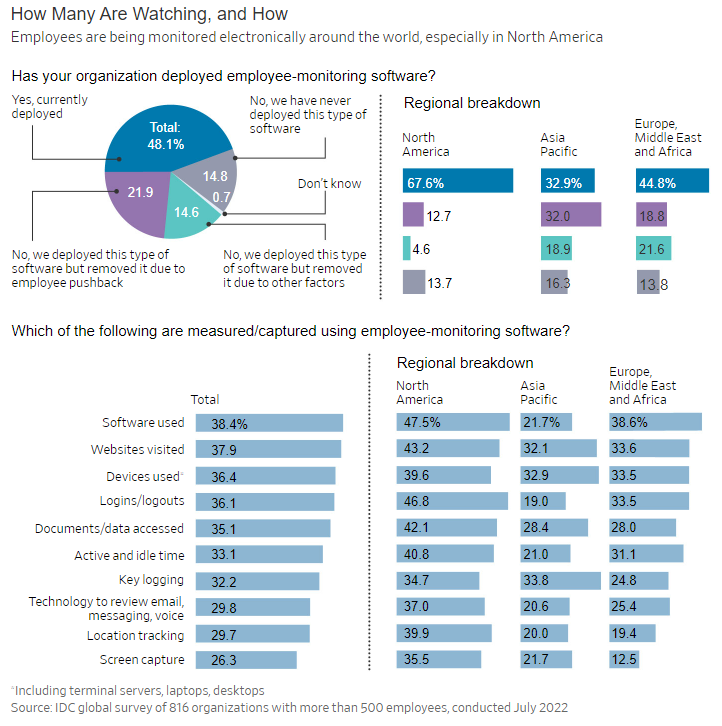One of the fastest technological adoptions by traditional corporates in history happened during the COVID-19 pandemic. I’m not referring to Microsoft Teams or Zoom.
Usage of employee monitoring software across companies went from 30% to over 60% in just 2.5 years.
Companies not trusting the people working for them is perhaps one of the most resounding failures of organizations.
Monitoring inputs instead of outcomes is an evident admission that companies are clueless on how to effectively, or at all, measure value creation by their own employees. This is a somewhat tricky challenge because, when outcomes are sufficiently abstract and hard to quantify, it may be tempting to use inputs as quantifiable proxy measures.

The reality is different though, and companies need to be a bit more creative and thoughtful to come up with a way to accurately measure impact.
The old guard’s solution to this problem is simple and simplistic at the same time.
Bring everybody back to the office. Kill remote working. Micro-manage.
Many web3 organizations that flourished over the last few years have adopted a remote-first way of working since inception. It is not unusual for web3 founders to work together for years before meeting in person, or for web3 companies to have employees and contractors sitting in dozens of different countries. At Bankless Consulting, we cover four continents with all our consultants and the genesis team has never met in person as a whole!
Web3 went remote-first because the benefits of remote work by far outweigh its downsides.
Offering a great work/life balance to employees, allowing travel while you work, enabling geo-arbitrage with salary and cost living, saving company’s budget in commercial real estate, and overall creating better conditions for the workers are some of the reasons why remote work took off so dramatically, also accelerated by the COVID crisis.
So, what can TradCos learn from the web3 approach?
Why killing remote work is wrong
Remote work is about empowering the individuals and trusting them that they will get the job done, no matter where they are physically located when doing that job.
Some argue that, especially for new joiners in an organization, remote work isn’t really that great. It creates barriers for the new hires to get to understand the company culture or its specific way of working, and this eventually impacts engagement - they say.
There are elements of truth there, but I challenge the solution proposal.
The effort should not focus on regressing to an inferior form of organizational design (employees back in offices), but rather on upgrading towards a better version of the present: let’s call it remote++.
Preaching that we should revert to the office context because remote does not work well in this or that particular use case would be the equivalent of having stopped any progress on the aircraft autopilot technology after the first crash.
Things are not perfect, but the trajectory is clear.

Focus on engagement…
The focus should shift back to talent engagement: how do we engage our team effectively?
A few ideas for consideration may include:
Alignment to the organization’s core mission is key when addressing the engagement levels of your workforce. Of course, a company’s aspirational purpose won't be attractive to all potential candidates out there, but it has to resonate with those that have the capabilities to advance your organization.
A culture of written communication is a plus for any team. It enables people that are not present at a meeting to catch up on the work without feeling being left out. Because writing is asynchronous, it saves time that is otherwise spent on calls, hybrid or in-person meetings, hence increasing productivity. Because clear writing is clear thinking, the team’s outputs will be higher in quality too.
Sterile-sounding missions such as “increasing shareholders’ value” do nothing to increase engagement. Creating happy customers works, not trying to make dollars for faceless people who you don't relate to, called “shareholders”.
Don’t rely exclusively on monetary incentives for motivation. Pay well to start with, and make career advancement a very achievable reward for performance excellence. Fast-track the best people, because those are likely the ones that embody your company’s values the most, and will naturally coach new joiners to become the resources your company needs.
Companies pay different wages to different people that perform the same job, and think those being paid less will ‘understand’. Instead, make sure that the allocation of benefits is fair and proportional to the outcomes produced.
All of the above is hard to accomplish consistently by organizations of any size but it’s important to create a work environment that features what Roger Martin refers to as a uniform and unfailing humanity.
…then look at processes and technology
Once you sort out your engagement problem, then you can tackle the process and technology challenges.
In a remote-first work environment, I agree that new resources at an organization may feel a bit left out when joining a new company. This is especially true in “apprenticeship” types of careers which, really, include most of the knowledge work.
Many crypto-ventures faced this challenge too, and experimented with various tactics to solve for it.
The strategy here is to create processes within your organization that break the technology-induced barriers of remote work.
A few ideas:
have regular phone or video call check-ins from leaders in your organization: this can do wonders for employees’ morale;
listen to the feedback of workers and action on it;
carefully craft an onboarding plan for new joiners: explain how you work, where to find the most important information about the company, interesting facts about team members, explain acronyms, etc. It should be all automated so to “curate” their initial couple of months at the new organization.
arrange regular all-day sessions, structured thoughtfully, similar to legacy All Hands or Town Halls. Have the employees meet in person where feasible. Have the new people meet and socialize. Provide and discuss updates on the business. Because these sessions need proper planning to be impactful, you can't have them too often. Find a cadence that works for your teams: perhaps start with a monthly frequency and finetune accordingly;
Share personal stories with your team members. Make a genuine effort to build a connection with them. Take time to get to know them as a person and create the opportunity for them to get to know you. Work together, synchronously, on a few tasks. Share your stories and share your screen.
Conclusive thoughts
Remote work is here to stay.
The companies that will be able to distill the right approaches and scale the most effective technologies will end up hiring and retaining the best talent out there.
Knowledge workers are spending their days immersed in their suite of digital communication tools and will be doing so more and more over the coming years. From design to meetings, to notes, to brainstorming, and other collaboration activities: it’s all online already if you haven’t noticed!
Organizations that will go “remote-first” and are thoughtful about the ways to engage their people will enable their teams to be faster, more efficient, more inclusive, and more transparent. Gone are the days of in-person politics and long commutes. Work will be done remotely and from anywhere by workers that feel humanized by their leaders when given the chance to perform at their best independently.
On the contrary, companies that abandon the remote-forward path will slowly lose ground against more progressive and innovative firms.
It's a market, after all.



